History of the Horse – Part 20
|
|
Geschichte des Pferdes – Teil 20
|
Our Times 9
- In the last Blogs (starting with Blog 17) we looked at the economic influence that the horse industry in general has today, culminating with the incredible sums of money that the horse racing industry generates. Another part of that economic sector is the
Breeding industry: Stud Farms
- Many nations in Europe are great horse countries due to traditions and favourable climate. Sport and race horses bred in Europe are highly successful in international competition and races. The best horses bring in very high prices (millions of Euros per horse) – and just look how they live!
|
|
Unser Zeitalter 9
- In den letzten Blogs (ab Blog 17) haben wir den wirtschaftlichen Einfluß der Pferdeindustrie generell betrachtet, der in den unglaublichen Summen gipfelt, welche die Pferderennen erzeugen.
Das Zuchtgeschäft: Landgestüte
- Viele Nationen in Europa sind wegen ihres Klimas und ihrer Tradition wichtige Pferdezuchtländer. Die in Europa gezüchteten Sport- und Rennpferde sind in internationalen Wettkämpfen sehr erfolgreich. Die besten Pferde bringen sehr hohe Preise, manchmal Millionen Euro pro Pferd – nicht schlecht, wie die leben!
|
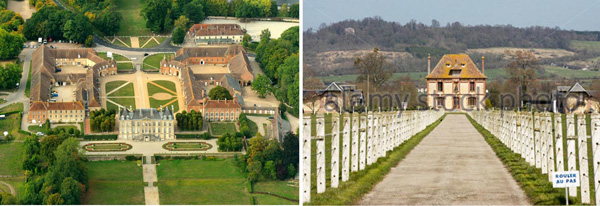 The French National Stud Farm and a Haras in Normandy
Das französische staatliche Landgestüt und eine “haras” in der Normandie.
|
- The word “Stud” comes from the old English “stod” meaning a place where a herd of horses was kept for breeding. During the Middle Ages stud farms were often managed in monasteries. As then few people could write, it fell to the monks (who could) to record the pedigrees. The Carthusian monks were famous for their breeding of the Andalusian horses for example.
|
|
- Landgestüte sind Anwesen, wo Herden zum Zweck der Zucht gehalten werden. Im Mittelalter wurden sie oft von Klöstern betrieben. Da damals wenige Menschen schreiben konnten, fiel es den Mönchen (die es konnten) zu, die Abstammungsnachweise aufzuzeichnen. Die Karthusischen Mönche zum Beispiel waren für ihre andalusische Pferdezucht berühmt.
|
 Two studfarms in Andalusia
Zwei Gestüte in Andalusien |
- Many stud farms belonged to the State. The first state studs were ordered by Louis 14th of France in 1665. The purpose of the state studs was to make high-quality horses available to local breeders and farmers to accelerate the evolution of local horses.
- Germany is most famous for its Principal and State Studs (the Hanoverian of Celle, the Westphalian of Warendorf and so on).
- Germany (Marbach 1477) for Arabians, Black Forest Horses, Haflingers and other Warmbloods
- Slovenia (Lipica from 1580) for the Lipizzans
- Czec Republic (Kladrub 1579) for the Kladruber
- Hungary (Babolna 1789) for Arabian horses
- Romania (Radautz 1792)
- Austria (Piber 1798) for Lipizzaner
- Poland (Janow Podlaski 1817 ) for Arabians
- Russia (Trakehnen) for Trakehner
And so on. |
|
- Viele Landgestüte gehörten dem Staat. Die ersten staatlichen Zuchthengste wurden in Frankreich von Louis 14. um 1665 eingesetzt. Der Grund für solche „Staatshengste“ war den örtlichen Züchtern die Chance zu geben, die einheimischen Pferderassen mit hochqualizifierten Veranlagungen zu verbessern.
- Deutschland ist für seine staatlichen Landgestüte berühmt, in Celle für Hanoveraner, Warendorf für Westphalen usw.
- Ebenfalls in Marbach (seit 1477) für Araber, Schwarzwälder, Haflinger und andere Warmblüter
- Slovenien (Lipica besteht seit 1580) für seine Lipizzaner
- Die Tschechei für die Kladruber (Kladrub besteht seit 1579)
- Ungarn hat Babolna für seine Araber
- Rumänien hat Radautz seit 1792
- Österreich Piber (seit 1798) für Lipizzaner
- Polen hat Araberzucht (Janow Podlaski 1817 )
- Rußland die Trakehner
Und so weiter. |
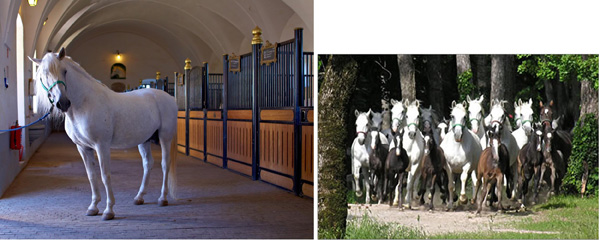 The famous Lipizzaner in Slovenia
Die berühmten Lipizzaner in Slovenien
|
- Private Stud Farms also exist, most of them dedicated to purebred livestock, such as the historic Claiborne Farm in Kentucky USA or Darley Stud, owned by a Sheikh in Dubai.
|
|
- Es gibt auch private Gestüte, von denen sich die meisten ebenfalls auf reinrassige Zucht spezialisieren, wie z. B. die Claiborne Farm in Kentucky USA oder Darley Stud, welches einem Sheikh in Dubai gehört.
|
 Private studfarms in Dubai (left) and India (right)
Private Gestüte in Dubai (links) und Indien (rechts) |
- European breeding associations run selection programmes and keep stud books. The use of semen instead of natural matings in warmblood and harness racing breeds has increased the exchange of breeding stock, and enabled improved genetic qualities of the horses. Artificial insemination is not allowed in Thoroughbred breeding.
|
|
- Europäische Zuchtverbände veranstalten Hengstleistungsprüfungen und führen Zuchtbücher. Der Einsatz von künstlicher Besamung bei Warmblütern und Trabrennrassen hat den Austausch der Zuchtanlagen vereinfacht und genetische Qualitäten der Pferde verbessert. Künstliche Besamung ist bei Vollblütern nicht erlaubt.
|
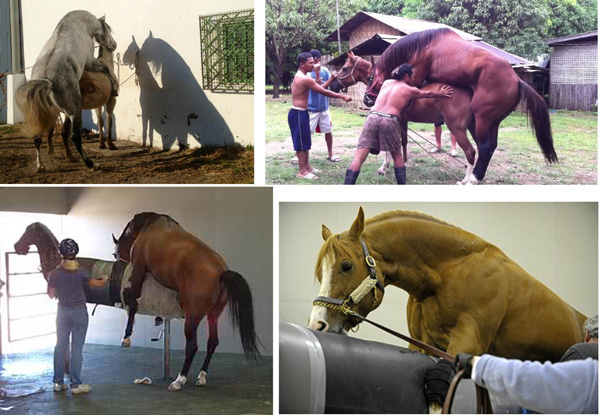 Breeding as nature planned it and artificial insemination below.
Natürliche Paarung und unten künstliche Besamung. |
- In the European countries the state stud farms are of varied importance.
- For instance,in Poland there are 28 state stud farms, in which the famous Polish Arabians are bred.
- in France there are presently 19 public stud farms,
- Germany has 10 state stud farms of which the Stud of Celle is the largest one, and
- in the Czech Republic, Hungary, Slovenia, Austria and Romania Lipizzaner horses are bred on state stud farms.
- In Sweden, the former state stud Flyinge was privatized in 1983, and has since then been run by a private foundation.
Our relationship to the horse nowadays:
- As society has modernized the relation between the horse and the human being has changed. The horse today is used for competition in equestrian sport including the Olympic disciplines show jumping, dressage, eventing and racing.
- The use of the horse however is not restrained to competition. The horse engages many people of all ages in leisure activities.
Riding Schools
- In almost all countries of the European Union it is usual to start riding in a riding school. The number of riding schools or riding clubs in countries investigated by the Web Source is nearly 15,000. These riding school offer a valuable opportunity for youths to learn in groups and for affordable prices to learn with and about horses. In vaulting groups the children learn to lose their fright of the height and tempo on horseback – they learn to control their own bodies before they have to master the horses.
- In North America this is different: here children are mostly introduced to riding in private lessons on school ponies or even need to lease their own horse to be able to do so. This restricts the sport to the wealthier classes.
|
|
- In verschiedenen europäischen Ländern haben die Gestüte mehr oder weniger Wichtigkeit.
- Z.B.:Gibt es in Polen 28 staatliche Gestüte, in denen die berühmten polnischen Araber gezüchtet werden.
- In Frankreich gibt es 19 Landgestüte,
- in Deutschland 10, von denen Celle das größte ist, und
- in der Tschechei, Ungarn, Slovenien, Österreich und Rumänien werden in staatlichen Gestüten die Lipizzaner gezüchtet.
- In Schweden wurde das frühere Flyinge Landgestüt 1983 privatisiert und wird seitdem von einer privaten Stiftung geführt.
Unser heutiges Verhältnis zum Pferd:
- Wie sich die Gesellschaft modernisiert hat, hat sich das Verhältnis von Mensch und Pferd verändert. Heutzutage wird das Pferd für den sportlichen Wettkampf, einschließlich der Olymipschen Spiele mit Springen, Dressur, Military und Rennen benutzt.
- Jedoch ist die Verwendung des Pferdes nicht auf den Wettkampf beschränkt. Viele Menschen sind in aller Art von Freizeitreiten engagiert.
Reitschulen
- In fast allen Ländern der europäischen Union beginnt man mit dem Reitunterricht in einer Reitschule. Die Zahl der von meiner Webquelle untersuchten Reitschulen beläuft sich auf fast 15 000. Diese Reitschulen bieten den Jugendlichen eine wertvolle Möglichkeit zu erschwinglichen Preisen im Gruppenunterricht über und mit Pferden zu lernen. In Voltigegruppen lernen die Kinder zuerst die Angst vor der Höhe und dem Tempo zu verlieren – sie lernen den eigenen Körper beherrschen, ehe sie die Pferde selbst lenken müssen.
- In Nordamerika ist das anders: hier fangen Kinder meist in Privatunterricht auf einem gemieteten Pony an, oder sie müssen sogar ein eigenes Pferd leasen- das beschränkt den Sport wieder auf die vermögenderen Schichten.
|
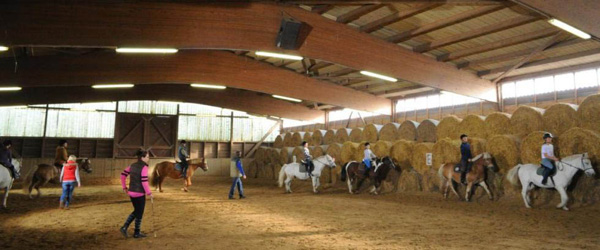 In Europe most children start riding in groups – in riding schools, which offer lessons at reasonable prices.
In Europa fangen die meisten Kinder mit dem Reiten in der Abteilung an, was erschwinglich ist.
|
- Studies show that children who regularly handle horses mature faster. Also the riding school in itself can act as a place for youngsters (mostly girls) to develop and strengthen their identity. Working with horses promotes skills, responsibility, courage and initiative.
|
|
- Untersuchungen zeigen, daß sich Kinder, die regelmäßig mit Pferden umgehen, schneller entwickeln. Die Reitschulen helfen den Jugendlichen (meist Mädchen) auch ihre eigene Identität zu finden und zu festigen. Mit Pferden arbeiten fördert Geschicklichkeit, Verantwortungsgefühl, Mut und Initiative.
|
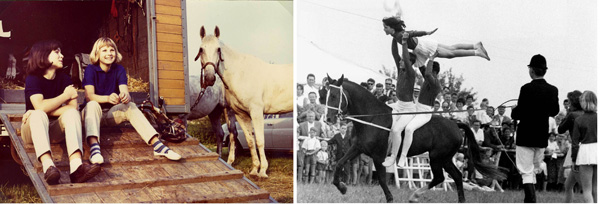 In the 1960 – our life around the stables was simple and happy. Most of us vaulted before becoming riders.
In den 1960er Jahren war unser Stalleben einfach und glücklich. Die meisten voltigierten bevor sie Reiter wurden.
|
- I certainly spent my happiest times in the stables during my teens and I learned a lot of useful things – because we still had to help! From pitching hay to mucking out, from treating sick horses to fixing and painting fences and obstacles – we did it all. We even had to pick the cherries for free (and were supposed to not eat them – ha!!). Whenever my Latin tests were unsatisfactory (which they always were, because I detested Latin!) I was not allowed to go to my next vaulting session – those were the bitterest moments. And since in those days boys had not yet given up riding (in fact, at the local shows the jumping was mostly done by men), it was a very mixed and interesting company we were in.
The horse and the environment
- The land area required to produce horse feed varies extensively between countries with the yield of the grazing according to their climate. Compare the land required to keep a warmblood horse of 0.75 ha/horse in Ireland and 2.21 ha/horse in Greece. Assuming that all horse feed is produced within the country the share of the total agricultural land needed to feed a horse varies between 1% and 20% of the total agricultural land.
|
|
- Ich jedenfalls habe die glücklichsten Stunden meiner Teen-Jahre im Stall verlebt – und viel Nützliches dabei gelernt, denn wir mußten helfen! Vom Heustapeln bis zum Ausmisten, von der Pflege kranker Tiere bis zum Zäune reparieren und streichen – wir lernten alles. Wir mußten sogar kostenlos Kirschen ernten (und sollten dabei nicht naschen – ha!!) Immer, wenn meine Lateinarbeiten schlecht waren (und das waren sie immer, da ich Latein haßte!) durfte ich nicht zur Voltige – das war bitter. Und da damals die Jungens das Reiten noch nicht aufgegeben hatten (tatsächlich wurde das Springen auf den Turnieren fast nur von Männern betrieben), war es eine sehr interessante und gemischte Gesellschaft, in der wir sportelten.
Das Pferd und die Umwelt
- Die Grundfläche, die man benötigt, um Futter für Pferde bereitzustellen, variiert je nach Klima – für ein Warmblutpferd z.B. in Irland von etwa 0,75 ha/Pferd bis zu 2,21 ha/Pferd in Griechenland. Mal angenommen, alles Futter würde innerhalb des Landes produziert, so wäre der Anteil der Pferdehaltung an der ganzen Landwirtschaft zwischen 1% und 20%.
|
 A studfarm in New Zealand – right: in Germany. Such living quarters are not bad!
Ein Gestüt in Neuseeland – rechts in Deutschland. So ein Wohnzimmer ist nicht schlecht!
|
- The horse has many positive effects on environment – biodiversity and alternative use of land. However the horse also constitutes a certain amount of environmental burden. A horse produces about 20 kg of manure every day which may contribute to a run off of mainly Nitrogen and Phosphorous. According to calculations based on the number of horses in the respective countries the manure from horses in Europe reach nearly 100,000 tons. Not all manure is used as fertilizer.
- Manure from stables in urban areas is instead often sent to waste deposals or combustion plants. Therefore in order to develop an environmentally sustainable horse industry this problem remains to be solved. There could for example be a potential to use manure in the production of bio energy fuels.
At least this Blog was more positive in mood! Looking at those stud farms, one could almost wish to be a horse…. ALMOST!
Read on !!!
|
|
- Pferdehaltung hat viele positive Auswirkungen auf die Umwelt – Biodiversität und alternative Landnutzung. Aber sie bringt auch eine Belastung mit sich. Ein Pferd produziert ungefähr 20 Kilo Mist pro Tag, was zu einem Überschuß an Stickstoff und Phosphor führt. Nach Berechnungen mit der Anzahl von Pferden in den untersuchten Ländern summiert sich der Mist in Europa auf fast 100 000 Tonnen im Jahr. Nicht aller Mist wird als Dünger verwendet.
- Der Mist aus Ställen in stadtnahen Gegenden wird oft auf Deponien oder zu Verbrennungsanlagen abgeführt. Daher muß das Problem einer nachhaltigen Pferdeindustrie noch gelöst werden. Vielleicht kann der Mist eines Tages in der Produktion von Bio-Energie-Kraftstoff verwendet werden.
Wenigstens war dieser Blog mal ein bißchen positiver! Wenn man die Bilder der Landgestüte betrachtet, möchte man doch fast ein Pferd sein… FAST!
Lesen Sie weiter !!!
|









